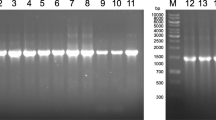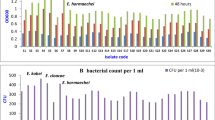Abstract
The biosorption of copper (II) from aqueous solution using different bacterial strains was studied. Copper-biosorbing bacteria were isolated from tannery effluent collected from Borg Al-Arab, Alexandria, Egypt. These isolates displayed different degrees of copper biosorption under aerobic conditions. Based on 16S rDNA gene sequence analysis, three of them (S2, S5 and S7) were identified as Chryseobacterium sp., Enterobacter sp. and Stenotrophomonas sp., respectively. Initial copper (II) ion concentrations from 25–250 mg/L at constant temperature 30 °C were studied. The residual copper (II) concentration and its toxicity effect in solution were determined using atomic absorption spectrophotometer and bioluminescent bioreporter. The bioluminescence inhibition of strain (S5) reached to 91.4 % as compared with the strain (S7) reached to 83.3 % at 225 mg/L of copper ion where the maximum biosorption efficiency for S5 and S7 were 71 % and 70.1 % correspondingly using atomic absorption. The bioluminescent bioreporter was proved to be fast and accurate technique for measurement the toxicity effect of residual copper (II) in solution.
Similar content being viewed by others
References
Abdel-Ghani, N. T.; Hegazy, A. K.; El-Chaghaby, G. A., (2009). Typha domingensis leaf powder for decontamination of aluminium, iron, zinc and lead: Biosorption kinetics and equilibrium modeling. Int. J. Environ. Sci. Tech., 6(2), 243–248 (6 pages).
Abd-El-Haleem, D.; Moawad, H.; Zaki, E. A.; Zaki S., (2002b). Molecular characterization of phenol-degrading bacteria isolated from different egyptian ecosystems. Microb. Ecol., 43(1), 217–224 (8 pages).
Abd-El-Haleem, D.; Zaki, S.; Abulhamid, A.; Elbery, H.; Abu Elreesh, G., (2006). Acinetobacter bioreporter assessing heavy metals toxicity. J. Basic Microbiol., 46(5), 339–347 (9 pages).
Abd-El-Haleem, D.; Layton, A.; Sayler, G., (2002a). Long-PCR amplified rDNA apply for PCR-RFLP and REP-PCR based approaches to recognize closely related microbial species. J. Microbio. Meth., 49(3), 315–318 (4 pages).
Abd-El-Haleem, D.; Kheiralla, Z.; Zaki S.; Rushdy A.; Abd-El-Rahiem, W., (2003). Multiplex-PCR and PCR-RFLP assays to monitor water quality against pathogenic bacteria. J. Environ. Monit., 5(4), 865–870 (6 pages).
Adesola Babarinde, N. A.; Oyesiku, O. O.; Dairo O.F., (2007). Isotherm and thermodynamic studies of the biosorption of copper (II) ions by Erythrodontium barteri. J. Physic. Sci., 2(11), 300–304 (5 pages).
Alluri, H. K.; Ronda, S. R.; Settalluri, V. S.; Bondili, J. S.; Suryanarayana, V.; Venkateshwar, P., (2007). Biosorption: an eco-friendly alternative for heavy metalremoval. Afr. J. Biotechnol., 6(25), 2924–2931 (8 pages).
Altschul, S. F.; Gish, W.; Miller, W.; Myers, E. W.; Lipman, D. J., (1990). Basic local alignment search tool. J. Mol. Biol., 215(3), 403–410 (8 pages).
Andreazza, R.; Pieniz, S.; Wolf, L.; Lee, M.; Camargo, F. A. O.; Okeke, B. C., (2010). Characterization of copper bioreduction and biosorption by a highly copper resistant bacterium isolated from copper-contaminated vineyard soil. Sci. Total Environ., 408(1), 1501–1507 (7 pages).
Babel, S.; Opiso, E. M., (2007). Removal of Cr from synthetic wastewater by sorption into volcanic ash soil. Int. J. Environ. Sci. Tech., 4(1), 99–107 (10 pages).
Brierley, C. L., (1990). Bioremediation of metal-contaminated surface and groundwaters, Geomicrobiol. J., 8(3–4), 201–223 (23 pages).
Burlage, R. S.; Bemis, L. A.; Layton, A. C.; Sayler, G. S.; Larimer, F., (1990). Comparative genetic organization of incompatibility group P degradative plasmids. J. Bacteriol., 172(12), 6818–6825 (8 pages).
Calomoris, J. J.; Armstrong, T. L.; Seidler, R. J., (1984). Association of metal-tolerance with multiple antibiotic resistance of bacteria isolates from drinking water. Appl. Environ. Microbiol., 47(6), 1238–1242 (5 pages).
Celaya, R. J.; Noriega, J. A.; Yeomans, J. H.; Ortega, L. J.; Ruiz-Manr’ýquez A., (2000). Biosorption of Zn(II) by Thiobacillus ferrooxidans. Bioproc. Eng., 22(6), 539–542 (4 pages).
Chang, J. S.; Hong, J., (1994). Biosorption of mercury by the inactivated cells of Pseudomonas aeruginosa PU21. Biotechnol. Bioeng., 44(8), 999–1006 (8 pages).
Chang, J. S.; Law, R.; Chang, C. C., (1997). Biosorption of lead, copper and cadmium by biomass of Pseudomonas aeruginosa PU21. Water Res., 31(7), 1651–1658 (8 pages).
Chen, B. Y; Utgikar, V. P.; Harmon, S. M.; Tabak, H. H.; Bishop, D. F.; Govind, R., (2000). Studies on biosorption of zinc(II) and copper(II) on Desulfovibrio desulfuricans. Int. Biodeterior. Biodegrad., 46(1), 11–18 (8 pages).
Davis, J. A.; Volesky, B.; Vierra, R. H. S. F., (2000). Sargassum seaweed as biosorbent for heavy metals. Water Res., 34(17), 4270–4278 (6 pages).
Fourest, E.; Roux, J. C., (1992). Heavy metal biosorption by fungal mycelia by-product mechanisms and influence of pH. Appl. Microbiol, Biotech., 37(13), 399–403 (5 pages).
Hall, T. A., (1999). BioEdit: A user-friendly biological sequence alignment editor and analysis program for Windows 95/98/ NT. Nucl. Acids. Symp. Ser., 41, 95–98 (4 pages).
Hamman, S., (2004). Bioremediation Capabilities of White Rot Fungi. No. BI570 — review article Spring.
Kahru, A.; Pollumaa, L.; Reiman, R.; Ratsep, A.; Liiders, M.; Maloveryan, A., (2000). The toxicity and biodegradability of eight main phenolic compounds characteristic to the oil-shale industry wastewaters: A test battery approach. Environ. Toxicol. 15(5), 431–442 (12 pages).
Kobya, M.; Demirbas, E.; Senturk, E.; Ince, M., (2005). Adsorption of heavy metal ions from aqueous solutions by activated carbon prepared from apricot stone. Bioresour. Tech., 96(13), 1518–1521 (4 pages).
Kurek, E.; Czaban, J.; Bollag, J., (1982). Sorption of cadmium by microorganisms in competition with other soil constituents. Appl. Environ. Microbiol., 43(5), 1011–1015 (5 pages).
Lane, D. J., (1991). 16S/23S rRNA Sequencing. in: Stuckebrandet, E.; Goodfellow, M., (Eds.) Nucleic acid techniques in bacterial systematic. John Wiley and Sons, New York, 115–1 48 (34 pages).
Liu, Y.; Chang, X.; Guo, Y.; Meng, S., (2006). Biosorption and preconcentration of lead and cadmium on waste Chinese herb Pang Da Hai, J. Hazard. Mater., B135, 389–394 (6 pages).
Lodeiro, P.; Cordero, B.; Barriada, J. L.; Herrero, R.; Sastre de Vicente, M. E., (2005). Bosorption of cadmium by biomass of brown marine Macroalgae. Bioresour. Tech., 96(1), 1796–1803 (8 pages).
Mahvi, A. H., (2008). Application of agricultural fibers in pollution removal from aqueous solution. Int. J. Environ. Sci. Tech., 5(2), 275–285 (11 pages).
Malakootian, M.; Nouri, J.; Hossaini, H., (2009). Removal of heavy metals from paint industries wastewater using Leca as an available adsorbent. Int. J. Environ. Sci. Tech., 6(2), 183–190 (8 pages).
Nameni, M.; Alavi Moghadam, M. R.; Arami, M., (2008). Adsorption of hexavalent chromium from aqueous solutions by wheat bran. Int. J. Environ. Sci. Tech., 5(2), 161–168 (8 pages).
Okafor, E. Ch., Opuene, K., (2007). Preliminary assessment of trace metals and polycyclic aromatic hydrocarbons in the sediments. Int. J. Environ. Sci. Tech., 4(2), 233–240 (8 pages).
Okeke, B. C., (2008). Bioremoval of hexavalent chromium from water by a salt tolerant bacterium, Exiguobacterium sp. GS1. J. Ind. Microbiol. Biot., 35(12), 1571–1579 (8 pages).
Okeke, B. C.; Laymon, J.; Crenshaw, S.; Oji, C., (2008). Environment and kinetic parameters for Cr (VI) bioreduction by a bacterial monoculture purified from Cr(VI)-resistant consortium. Biol. Trace Elem. Res., 123(1–3), 229–241 (13 pages).
Page, R. D., (1996). Treeview: An application to display phylogenetic trees on personal computers. Comput. Appl. Biosci., 12(4), 357–358 (2 pages).
Panjeshahi, M. H.; Ataei, A., (2008). Application of an environmentally optimum cooling water system design in water and energy conservation. Int. J. Environ. Sci. Tech., 5(2), 251–262 (12 pages).
Parungao, M. M.; Tacata, P. S.; Tanayan, G. C.; Trinidad, L. C., (2007). Biosorption of copper, cadmium and lead by copper-resistant bacteria isolated from Mogpog River, Marinduque. Philip. J. Sci., 136(2), 155–166 (12 pages).
Quershi, A. A.; Bulich, A. A.; Isenberg, D. L., (1998). Microtox toxicity test systems-where they stand today. In microscale testing in aquatic toxicology: Advances, techniques, and practice. in: Wells, P. G.; Lee, K.; Blaise, C. (Eds.), Boca Raton, Florida: CRC Press, 185–199.
Saitou, N.; Nei, M., (1987). The neighbour-joining method: A new method for reconstructing phylogenetic trees. Mol. Boil. Evol., 4(4), 406–425 (20 pages).
Samarghandi, M. R.; Nouri, J.; Mesdaghinia, A. R.; Mahvi, A. H.; Nasseri, S.; Vaezi, F., (2007). Efficiency removal of phenol, lead and cadmium by means of UV/TiO2/H2O2 processes. Int. J. Environ. Sci. Tech., 4(1), 19–25 (7 pages).
Shakibaie, M. R.; Khosravan, A.; Frahmand, A.; Zare, S., (2008). Application of metal resistant bacteria by mutational enhancement technique for bioremediation of copper and zinc from industrial wastes. Iran. J. Environ. Health. Sci. Eng., 5(4), 251–256 (6 pages).
Sharma, P.; Kumari, P.; Srivastava, M. M.; Srivastava, S., (2006). Removal of cadmium from aqueous system by shelled moringa oleifera lam. Seed powder. Bioresour. Tech., 97(2), 299–305 (7 pages).
Silva, R. M. P.; Rodrigez, A. A.; De Oca, J. M. G. M.; Moreno, D. C., (2009). Biosorption of chromium, copper, manganese and zinc by Pseudomonas aeruginosa AT18 isolated from a site contaminated with petroleum. Bioresour. Tech., 100(4), 1533–1538 (6 pages).
Sultan, S.; Hasnain, S., (2007). Reduction of toxic hexavalent chromium by Ochrobactrum intermedium strain SDCr-5 stimulated by heavy metals. Bioresour. Tech., 98(2), 340–344 (5 pages).
Tsezos, M., (1985). The selective extraction of metals from solutions by microorganisms. A brief overview. Can. Met. Q., 24(2), 141–144 (4 pages).
Vasudevan, P.; Padmavathy, V.; Dhingra, S. C., (2003). Kinetics of biosorption of cadmium on Baker’s yeast. Bioresour. Tech., 89(3), 281–287 (7 pages).
Vinodhini, R.; Narayanan, M., (2008). Bioaccumulation of heavy metals in organs of fresh water fish Cyprinus carpio (Common carp). Int. J. Environ. Sci. Tech., 5(2), 179–182 (4 pages).
Volesky, B., (1994). Advances in biosorption of metals: Selection of biomass types. FEMS Microbiol. Rev., 14(4), 291–302 (12 pages).
Vullo, D. L.; Ceretti, H. M.; Marýá Alejandra D.; Ramírez, S., A. M.; Zalts, A., (2008). Cadmium, zinc and copper biosorption mediated by Pseudomonas veronii 2th Ed., Bioresour. Tech., 99(13), 5574–5581 (8 pages).
WHO, (2010). Guideline for drinking water quality recommendations, (Vol. 1), World Health Organization, Geneva.
Yahaya, Y. A.; Don, M. M.; Bhatia, S., (2009). Biosorption of copper (II) onto immobilized cells of Pycnoporus sanguineus from aqueous solution: Equilibrium and kinetic studies. J. Hazard. Mater., 161(1), 189–195 (7 pages).
Zaki, S.; Abd-El-Haleem, D.; Abulhamd, A.; Elbery, H.; AbuElreesh, G., (2008). Influence of phenolics on the sensitivity of free and immobilized bioluminescent Acinetobacter bacterium. Microbiol. Res., 163(3), 277–285 (9 pages).
Zvinowanda, C. M.; Okonkwo, J. O.; Shabalala, P. N.; Agyei, N. M., (2009). A novel adsorbent for heavy metal remediation in aqueous environments. Int. J. Environ. Sci. Tech. 6(3), 425–434 (10 pages).
Author information
Authors and Affiliations
Corresponding author
Rights and permissions
About this article
Cite this article
Zaki, S., Farag, S. Isolation and molecular characterization of some copper biosorped strains. Int. J. Environ. Sci. Technol. 7, 553–560 (2010). https://doi.org/10.1007/BF03326164
Received:
Revised:
Accepted:
Published:
Issue Date:
DOI: https://doi.org/10.1007/BF03326164




